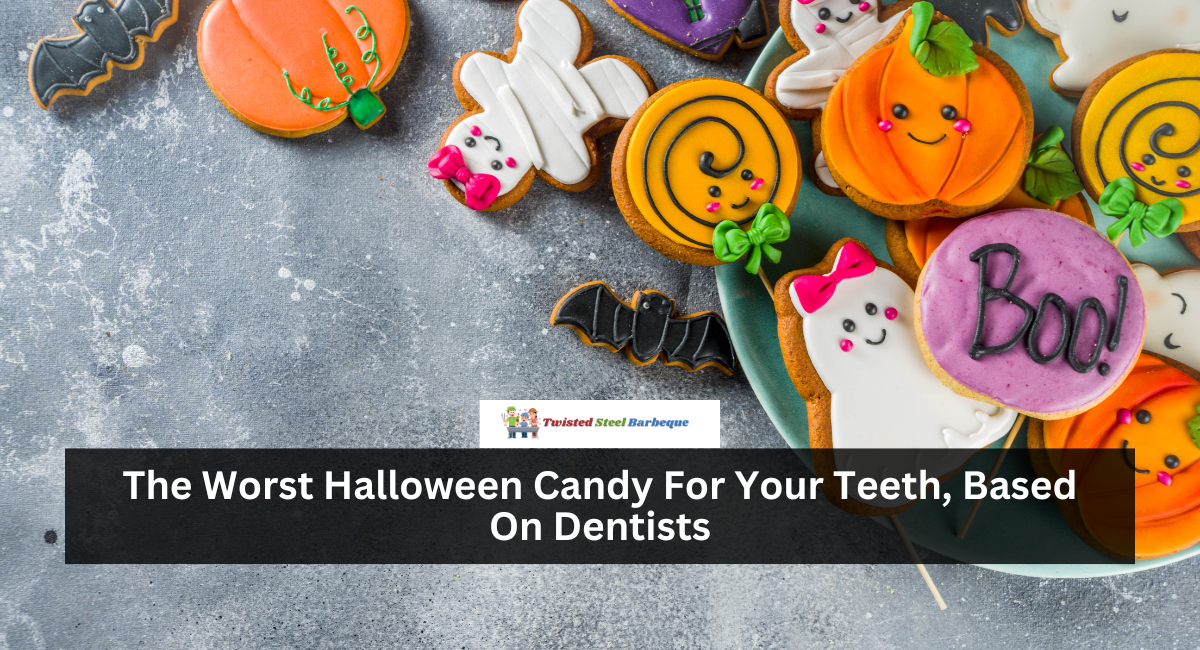When you consider Halloween, the first thing that most likely comes to mind is candy lots of it. October 31st is linked with sweet delicacies ranging from sour candies to chocolate bars.
Candy takes center stage one day of the year, and while indulging in some treats is practically certain, we sometimes forget about the impact candy has on our teeth.
Candy may truly damage things much beyond tooth decay, beyond generating cavities. Which sweets are the greatest offenders, and hence, what actual effect do these sweet treats have on our teeth? We sought professional advice from dentists so you will know how to guard your teeth should you want to indulge in your preferred Halloween sweets.
A Quick Refresher on the Issue with Sugar and Teeth
Let us first briefly discuss why sugar is so bad for your teeth before getting into which sweets are worst. According to Dr. Natasha M. Flake, president of the American Association of Endodontists, Halloween is the ideal moment to remind us why sugar from candy, drinks, and even juice can damage our dental health if we’re not careful.
Sugary meals cause the bacteria in our mouths to consume the sugar and create acid. This acid can then break down the enamel of the tooth, the protective layer that prevents decay. Consuming more sugar without sufficient care over time increases our likelihood of developing cavities or even more severe tooth issues.
The Worst Halloween Treats for Your Teeth
Although all sweets can damage teeth, some are more harmful than others. According to New York Family Dental Arts partner Dr. Irina Kessler, the most damaging sweets usually fit three basic categories: sticky, hard, and sour.
The reasons why these sweets are so dangerous:
1. Sticky Treatments
- Consider Sour Patch Kids, Laffy Taffy, and Tootsie Rolls. The sticky nature of these sweets allows them to adhere to teeth, particularly in hard-to-reach locations like molars. Dr. Flake says these sweets “cling to the teeth, leading to prolonged sugar exposure and an increased risk of decay.”
2. Sour Sweets
- Because they combine sugar and acid, sour candies like Warheads or Sour Patch Kids are especially dangerous. The acidic element can erode tooth enamel, increasing your teeth’ susceptibility to cavities. Many sour candies are sticky to exacerbate the situation, so they can readily get caught in your teeth and increase the exposure of acid and sugar.
3. Hard Candies
- Candy like lollipops, caramel sweets, and Jolly Ranchers provide a different hazard. Not only do they remain in your mouth for a long time, exposing your teeth to sugar for a longer period, but biting into them may also break or shatter them. According to Dr. Flake, this can cause uncomfortable problems like infections or, in severe situations, the necessity of a root canal or tooth loss.
Sucking on hard candy can still be harmful even if you’re not biting down on it. You might have pondered, “How many licks does it take to get to the center of a Tootsie Pop?” Your risk of tooth decay increases as your time there exposes more sugar to your teeth.
How to Savor Candy Without Risking Your Teeth
We all want to indulge in our preferred Halloween delicacies without thinking about serious tooth issues. Although you love sweets, fortunately, the dentists we spoke with gave some useful advice on how to reduce the harm.
Some easy methods to enjoy sweets and guard your teeth:
1. Eat Candy Following Dinner
- Dr. Flake advised consuming sweets right after meals. For what? Your mouth creates more saliva following a meal. This salivary surge helps balance the acids generated by the sugar in sweets, lowering the risk of tooth decay. It also helps clear food bits that could cling to your teeth.
2. Consumption Water
- Eat sweets, then sip lots of water. Water reduces the risk of cavities by helping to wash away sugary bits that can linger on your teeth.
3. Wait to Brush
- One of the most common errors individuals make is cleaning their teeth just after eating sweets. Dr. Flake counsels waiting at least thirty minutes before brushing. After the candy’s acids weaken your enamel, this allows it time to remineralize. By furthering the enamel damage, brushing too soon might cause more harm than benefit.
4. Balance is Essential
- Dr. Kessler says that moderation of sweets is vital. “Daily consumption of these sweets can result in cavities and other oral problems downstream,” she says. Try to restrict how much you eat in one sitting, even if it’s easy to dig into a large bag of Halloween sweets.
Stopping Cavities: Foundations of Excellent Oral Hygiene
Although these suggestions might help minimize the harm from sweet snacks, nothing compares to basic dental hygiene in terms of cavity prevention. Dr. Kessler emphasizes the need to keep up a regular dental cleaning schedule.
Here are some great habits to maintain your teeth healthy, particularly during candy season:
- To assist in eliminating food particles and plaque, brush twice a day with fluoride toothpaste.
- Daily flossing cleans between teeth, where a toothbrush cannot reach.
- For cleanings and examinations, see your dentist routinely at least twice a year.
- Cut back on your sugar intake from sweet beverages, including soda, juice, and candies.
Conclusion
Halloween is a great time of year, and partaking in your preferred sweets is customary. You should be aware, though, of how sugar could affect your teeth. Knowing which sweets provide the most danger and using basic oral health protection techniques can help you enjoy Halloween without sacrificing your smile.
The main realization is to Remember that not all sweets are made equal, stick to moderation, and practice proper dental hygiene. Halloween cavity-free is possible if you make wise, sweet selections and care for your teeth.
READ MORE: Top 10 Foods You Should Eat Every Day to Lose Fat

